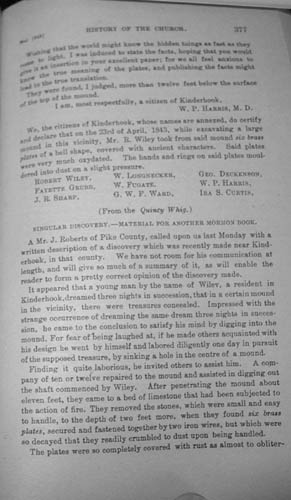Kinderhook plates: Image 6 of 8
![[First]](bw_first.gif)
|
![[Prev]](bw_prev.gif)
|
![[Index]](bw_index.gif)
|
![[Next]](bw_next.gif)
|
![[Last]](bw_last.gif) |
 |
|||||||||
Joseph Smith, History of the Church, Vol. 5, Ch. 9, p.377 Wishing that the world might know the hidden things as fast as they come to light, I was induced to state the facts, hoping that you would give it an insertion in your excellent paper; for we all feel anxious to know the true meaning of the plates, and publishing the facts might lead to the true translation. They were found, I judged, more than twelve feet below the surface of the top of the mound. I am, most respectfully, a citizen of Kinderhook, We, the citizens of Kinderhook, whose names are annexed, do certify and declare that on the 23rd of April, 1843, while excavating a large mound in this vicinity, Mr. R. Wiley took from said mound six brass plates of a bell shape, covered with ancient characters. Said plates were very much oxydated. The bands and rings on said plates mouldered into dust on a slight pressure.
(From the Quincy Whig.) SINGULAR DISCOVERY.—MATERIAL FOR ANOTHER MORMON BOOK. A Mr. J. Roberts of Pike County, called upon us last Monday with a written description of a discovery which was recently made near Kinderhook, in that county. We have not room for his communication at length, and will give so much of a summary of it, as will enable the reader to form a pretty correct opinion of the discovery made. It appeared that a young man by the name of Wiley, a resident in Kinderhook, dreamed three nights in succession, that in a certain mound in the vicinity, there were treasures concealed. Impressed with the strange occurrence of dreaming the same dream three nights in succession, he came to the conclusion to satisfy his mind by digging into the mound. For fear of being laughed at, if he made others acquainted with his design he went by himself and labored diligently one day in pursuit of the supposed treasure, by sinking a hole in the centre of a mound. Finding it quite laborious, he invited others to assist him. A company of ten or twelve repaired to the mound and assisted in digging out the shaft commenced by Wiley. After penetrating the mound about eleven feet, they came to a bed of limestone that had been subjected to the action of fire. They removed the stones, which were small and easy to handle, to the depth of two feet more, when they found six brass plates, secured and fastened together by two iron wires, but which were so decayed that they readily crumbled to dust upon being handled. The plates were so completely covered with rust as almost to |